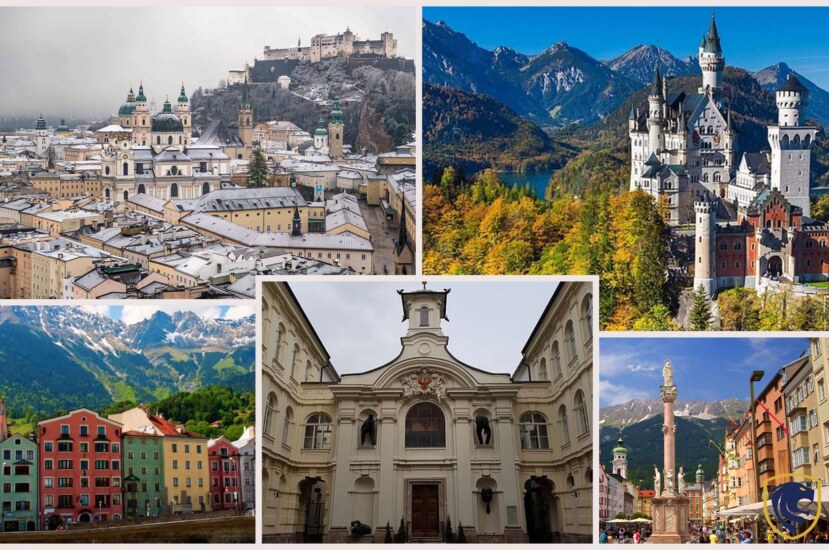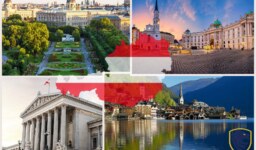Innsbruck, Austria, is steeped in history. This city, nestled in the heart of the Alps, has a rich tapestry of medieval and Renaissance landmarks. The Imperial Palace and the Golden Roof, a symbol of richness, are examples of Habsburg splendor. St. James’ Cathedral exudes Baroque beauty, while Ambras Castle maintains Renaissance art. In addition, the City Tower, standing sentinel, overlooks a historic metropolis. Also, Innsbruck’s streets reverberate with stories of emperors and cultural riches, making it an enticing location for anyone seeking a trip through time among breathtaking Alpine landscape.
Golden Roof (Goldenes Dachl)
Innsbruck, Austria‘s Golden Roof (Goldenes Dachl) stands tall as a symbol of the city. Archduke Frederick IV built it in the early 15th century, and it has 2,657 fire-gilded copper tiles that glitter in the sunshine. This famous monument in the center of Innsbruck’s Old Town is a work of medieval beauty. The Archduke could watch festivals and celebrations in the plaza below from the Golden Roof. It was also a showcase of riches and power, displaying the Habsburgs’ splendor. The magnificent balcony is also embellished with exquisite reliefs and embellishments, adding to its regal attractiveness.

Golden Roof (Goldenes Dachl)
The Golden Roof’s historical significance is evident, having seen various events and festivities throughout the years. The neighboring historic structures add to its prominence, providing a magnificent sight in the heart of Innsbruck. In addition, the Golden Roof is now a major tourist destination, attracting tourists from all over the world. The museum within gives information about the building’s history and its link to the Habsburg monarchy. From this vantage point, visitors may also enjoy panoramic views of the surrounding Alps.
The Golden Roof becomes golden as the sun sets, providing a pleasant glow across the area. It is still a testimony to the city’s rich legacy, encouraging tourists to journey back in time and enjoy Innsbruck’s historical architectural magnificence. To sum up the Golden Roof stands proudly today, a timeless symbol of Innsbruck’s cultural and historical past.
Imperial Palace (Hofburg)
Innsbruck’s Imperial Palace (Hofburg) is a historic Habsburg mansion. It was built in the 15th century and has magnificent architecture. Archduke Sigmund the Rich’s dwelling was the palace. Its courtyard is magnificent and enthralling. The Hofburg combines medieval and Renaissance elements to create a one-of-a-kind ambiance. Moreover, it has beautiful decorations and a lengthy history. The apartments of the palace are lavishly decorated and furnished in medieval style. Visitors are welcome to tour the many chambers and hallways.

Imperial Palace (Hofburg)
The value of the palace goes beyond its architectural splendor. It was important under the Habsburg era in Tyrol. It is now home to the Tyrolean Folk Art Museum. In addition, Tyrolean cultural items and exhibitions are on show in the museum.
The Hofburg is located in the center of Innsbruck and is a testimony to the city’s historical significance. The surrounding region provides a window into the past. Also, the Hofburg’s ties to the Habsburg family further add to its attraction. Tourists can enjoy the outside while also exploring the inside. The courtyard is a beautiful place to explore. For anyone interested in history and architecture, the Hofburg is a must-see. It embodies the grandeur of the Habsburg era and adds to Innsbruck’s cultural diversity.
Ambras Castle (Schloss Ambras)
Innsbruck’s Ambras Castle (Schloss Ambras) is a Renaissance jewel. Because it was built in the 16th century and sits gracefully on the city’s outskirts. The castle is surrounded by beautiful gardens and provides stunning views of the Alps. Ambras Castle, commissioned by Archduke Ferdinand II, is known for its architectural splendor. Its well-preserved Renaissance style has an eye-catching Spanish Hall with elaborate woodwork and murals. The atmosphere of the castle is both royal and peaceful.

Ambras Castle (Schloss Ambras)
Ambras Castle is home to an impressive collection of art and antiquities. The Chamber of Art and Curiosities houses a diverse collection of things ranging from armor and weaponry to exotic treasures. In addition, portraits, sculptures, and tapestries are among the artworks housed at the castle.
The Lower Castle is home to the Habsburg Portrait Gallery, which displays pictures of Habsburg kings. The Spanish Hall of the castle, with its woodwork inlays and colorful murals, is also an example of Renaissance artistry.
The surrounding grounds contribute to the castle’s allure, offering tourists with a tranquil backdrop. Furthermore, the “Hortus Inclusus,” a tiered garden, includes groomed grass, fountains, and statues.
Ambras Castle has been extensively restored in order to preserve its historical relevance. It is a cultural and architectural icon that draws people eager to learn about its fascinating past. In conclusion, the castle’s unique collections and picturesque environs make it a must-see in Innsbruck, providing a mesmerizing trip through Austria’s Renaissance period.
St. James’s Cathedral (Dom zu St. Jakob)
Innsbruck’s St. James’ Cathedral (Dom zu St. Jakob) is a Baroque masterpiece. It was built in the 18th century and is a notable religious landmark in the city center. St. James the Greater is the patron saint of the cathedral. The cathedral’s facade is towering and embellished with elaborate decorations. Moreover, the Baroque facade has detailed sculptures and ornamental accents. The Austrian Baroque architecture of St. James’ Cathedral is renowned.

St. James’s Cathedral (Dom zu St. Jakob)
The cathedral’s interior is breathtaking. In addition, the nave is ornately decorated and has lofty vaulted ceilings. The Mariahilf altar, which depicts the Virgin Mary, is a prominent point.
St. James’ Cathedral contains a number of chapels, each with its own distinct architecture and religious importance. Also, the atmosphere is serious and reverent, providing a calm setting for worship and reflection. The cathedral has a long history, having witnessed many events and rituals over the years. It has long been a sacred site and a symbol of faith for the local people.
The inside of the cathedral may be explored by visitors, who can marvel at its artistic and architectural aspects. The cathedral’s prominent location in Innsbruck’s Old Town makes it easily accessible and interesting. So, St. James’s Cathedral is a place of prayer as well as a cultural icon. Its Baroque beauty and religious significance make it a must-see for visitors interested in the country’s historical and architectural assets.
City Tower (Stadtturm)
The City Tower (Stadtturm) in Innsbruck, Austria, is a historic landmark. It was built in the 15th century and rises towering in the middle of the Old Town. The tower provides panoramic views of Innsbruck and the surrounding Alps. Furthermore, its characteristic green roof is a distinguishing feature. In addition, the City Tower acted as a watchtower and signified the city’s might. Climbing the tower affords a unique perspective of Innsbruck’s old buildings.

City Tower (Stadtturm)
The tower is roughly 51 meters tall, with 148 steps to the summit. Also, the ascent is rewarded with stunning views of the city and the Alps. Visitors may take beautiful shots from the observation platform.
City Tower has been renovated while retaining its historical beauty. It remains a focal point for city direction. Moreover, the clock atop the tower is a prominent landmark, and its chimes can be heard throughout Old Town. The Herzog-Friedrich Street position of the skyscraper makes it conveniently accessible. It is a popular tourist and local attraction. The City Tower is a visible remnant of Innsbruck’s medieval heritage. Ascending the tower is both historically significant and thrilling. Visitors may admire the architectural intricacies and contemplate the tower’s role in defending the city. In conclusion, the City Tower is a tribute to Innsbruck’s rich history and provides a stunning view of the picturesque Austrian city.


